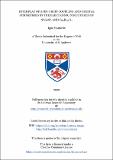Files in this item
Interplay of spin-orbit coupling and crystal symmetries in the electronic structures of NbGeSb and Ca₃Ru₂O₇
Item metadata
| dc.contributor.advisor | King, Phil | |
| dc.contributor.advisor | Mackenzie, Andrew | |
| dc.contributor.author | Markovic, Igor | |
| dc.coverage.spatial | xviii, 142 p. | en_US |
| dc.date.accessioned | 2020-09-01T11:05:20Z | |
| dc.date.available | 2020-09-01T11:05:20Z | |
| dc.date.issued | 2020-07-27 | |
| dc.identifier.uri | https://hdl.handle.net/10023/20531 | |
| dc.description.abstract | This thesis presents the study of electronic structure of two materials with strong spin-orbit coupling using angle-resolved photoemission spectroscopy (ARPES) experiments and density-functional theory (DFT) band calculations. The two materials are NbGeSb and Ca₃Ru₂O₇, which host weak and strong electronic interactions, respectively. While at first glance they seem rather disparate, I will show in both cases how novel phenomena emerge from the interplay of spin-orbit coupling and the crystal symmetries. In NbGeSb, I combine insights from spin-integrated and spin-resolved ARPES measurements with DFT slab calculations to reveal how band inversion of two pairs of spin-orbit coupled surface states along the edge of the Brillouin zone results in a peculiar crossing structure with two protected and two asymmetrically gapped crossing points. I show how this is caused by the presence of a mirror symmetry line assigning definite mirror parity to orbital and spin angular momentum of the bands. This leads to a low-energy description of the crossing points equivalent to a two-dimensional Weyl equation, establishing them as 2D analogues of Weyl points. In Ca₃Ru₂O₇, on the other hand, spin-orbit coupling provides a link between the electronic structure, the underlying antiferromagnetic order and the inherent antipolar distortion in the crystal structure. Our results reveal that a known structural and spin reorientation transition is caused by a spin-orbit derived gapping of a large Fermi surface. The hybridisation term couples the magnetic moment direction with the antipolar distortion of the crystal structure, and is only unlocked when the resulting electronic energy gain becomes enough to overcome the cost of spin reorientations. These findings together highlight the abundance of possibilities for novel phenomena arising from the interplay of spin-orbit coupling and crystal symmetries in quantum materials. | en_US |
| dc.language.iso | en | en_US |
| dc.publisher | University of St Andrews | |
| dc.relation | Interplay of spin-orbit coupling and crystal symmetries in the electronic structures of NbGeSb and Ca₃Ru₂O₇ (thesis data) Marković, I., University of St Andrews. DOI: https://doi.org/10.17630/65018c0a-112c-41f8-b3da-1d1e7920445d | en |
| dc.relation.uri | https://doi.org/10.17630/65018c0a-112c-41f8-b3da-1d1e7920445d | |
| dc.rights | Creative Commons Attribution-NonCommercial-NoDerivatives 4.0 International | * |
| dc.rights.uri | http://creativecommons.org/licenses/by-nc-nd/4.0/ | * |
| dc.subject | Photoemission spectroscopy | en_US |
| dc.subject | Electronic structure | en_US |
| dc.subject | Crystal symmetries | en_US |
| dc.subject | Spin-orbit coupling | en_US |
| dc.subject.lcc | QC176.8E4M28 | |
| dc.subject.lcsh | Electronic structure | en |
| dc.subject.lcsh | Photoelectron spectroscopy | en |
| dc.subject.lcsh | Energy-band theory of solids | en |
| dc.title | Interplay of spin-orbit coupling and crystal symmetries in the electronic structures of NbGeSb and Ca₃Ru₂O₇ | en_US |
| dc.type | Thesis | en_US |
| dc.contributor.sponsor | University of St Andrews | en_US |
| dc.contributor.sponsor | International Max Planck Research School for Chemistry and Physics of Quantum Materials (IMPRS-CPQM) | en_US |
| dc.type.qualificationlevel | Doctoral | en_US |
| dc.type.qualificationname | PhD Doctor of Philosophy | en_US |
| dc.publisher.institution | The University of St Andrews | en_US |
| dc.publisher.department | Max Planck Institute for Chemical Physics of Solids | en_US |
| dc.identifier.doi | https://doi.org/10.17630/10023-20531 |
The following licence files are associated with this item:
This item appears in the following Collection(s)
Except where otherwise noted within the work, this item's licence for re-use is described as Creative Commons Attribution-NonCommercial-NoDerivatives 4.0 International
Items in the St Andrews Research Repository are protected by copyright, with all rights reserved, unless otherwise indicated.


